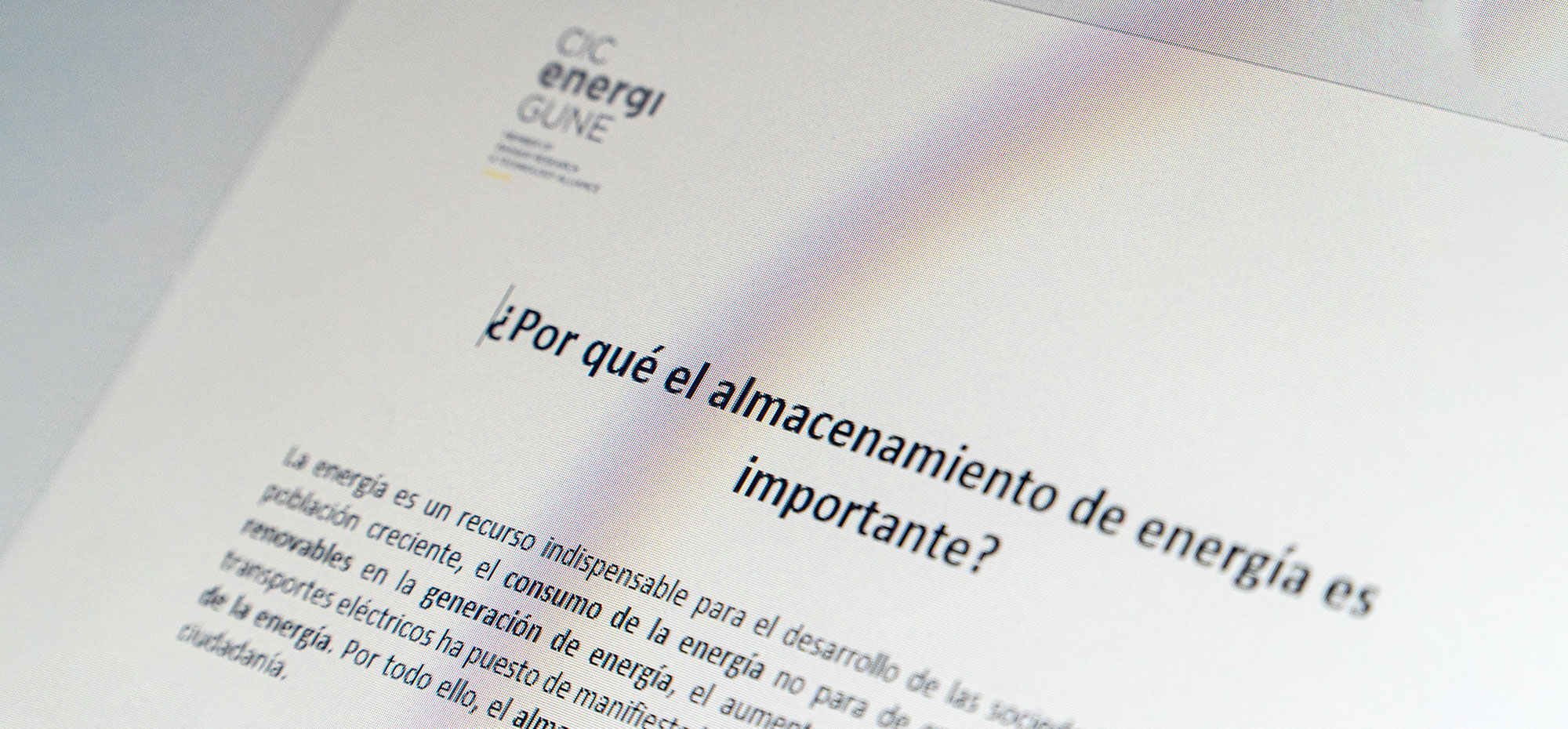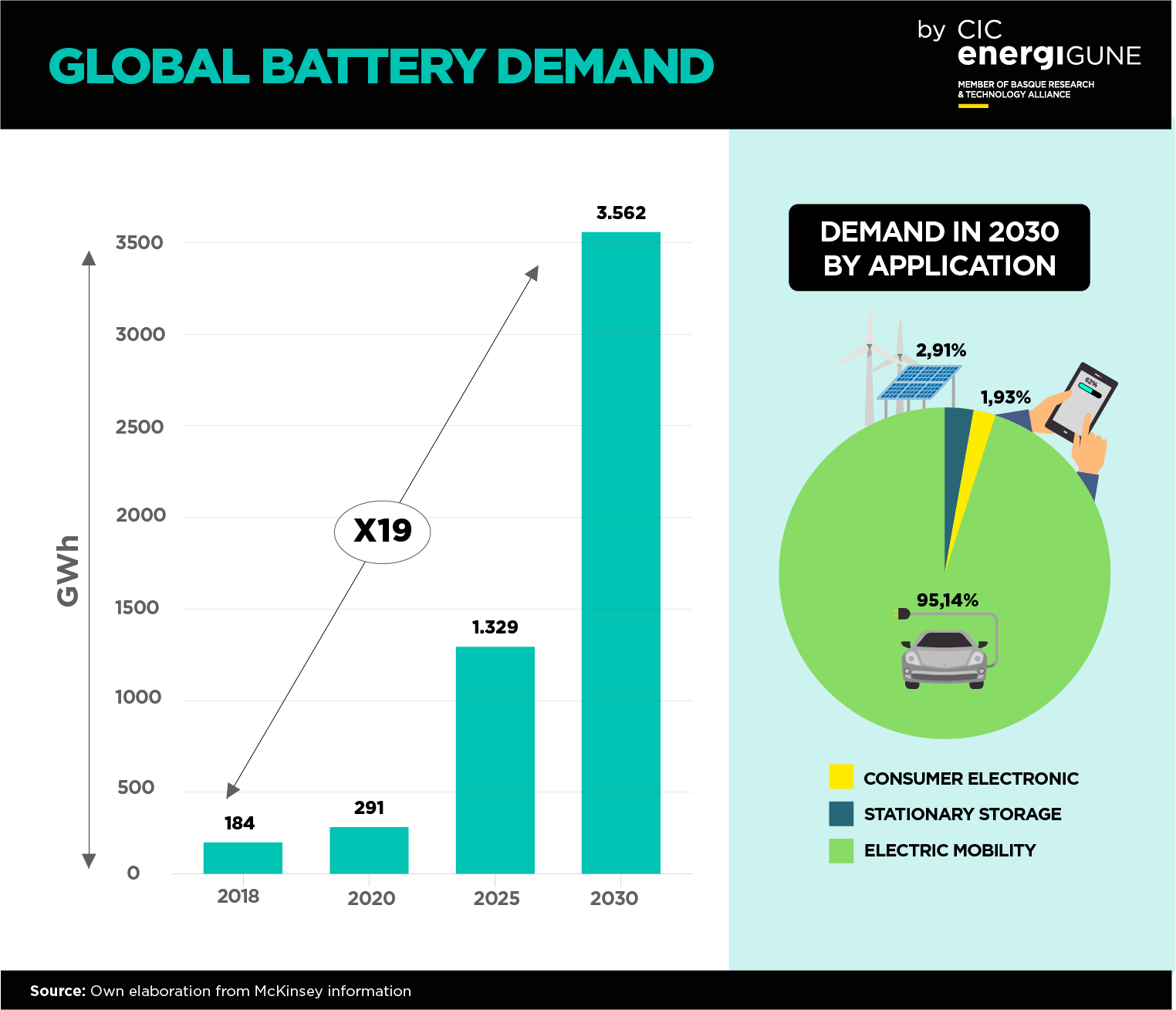However, this means, in turn, other major challenges to be faced, as we could see in one of the surveys we carried out on our social media profiles. According to this survey, the majority (approx. 65-70%) of respondents believed that the biggest obstacle facing the battery industry is precisely the shortage of raw materials.
Indeed, some of the materials used to produce batteries are classified by international organizations as critical raw materials (CRM). Hence, Europe´s objective in this area is to develop its own market for sustainable raw materials through the European Raw Materials Alliance (ERMA), to which CIC energiGUNE belongs. In other words, raw materials that are abundant in nature, have a low impact on the environment and are not exploited undermining fundamental human rights.
To this end, research is a fundamental agent, since it studies the qualities of the different raw materials and the possible interactions between them. At CIC energiGUNE we have numerous lines of research and we collaborate in international projects that are already obtaining very encouraging results to develop more affordable, efficient, safe and sustainable batteries that promote the electrification of society.
Zinc-air-batteries
Zinc-air batteries, part of the metal-air battery research line, represent one of the most attractive technologies for the scientific and industrial community as a sustainable alternative to the use of critical battery materials.
Among its qualities, the following stand out:
- The high recyclability and cost-effectiveness of zinc (non-CRM) as an anode active material, helping to obtain a solution with very low production costs.
- The use of very abundant and environmentally friendly materials, such as the reuse of oxygen (extracted from ambient air) as cathode active material.
- The presence of a non-toxic and non-flammable aqueous electrolyte (KOH solution), which makes the device easier to handle and safer.
- Competitive energy and power densities. In fact, the theoretical energy density of zinc-air batteries is higher than that of lithium batteries.
Despite their low dependence on CRM materials and good performance for stationary applications, these batteries from the so-called "beyond lithium-ion" era still have some challenges to overcome in order to compete in the market.
One of these is rechargeability. Although primary zinc-air batteries have been on the market for many years, their rechargeable version has not come to the fore until the recent development of new electrocatalysts based on nickel, manganese, silver or iron (none of which are critical materials) that allow them to be recharged.
CIC energiGUNE´s metal-air battery research line is devoting great efforts to the development of new formulations, more active catalysts and more efficient recycling processes so that these batteries made of sustainable, safe and inexpensive materials will be competing in the stationary market in the coming years.
Sodium-ion batteries
Another technology that stands out as a sustainable alternative to the use of critical battery materials is sodium-ion. Moreover, the fact that they are positioned as one of the most sustainable technologies for energy storage is no coincidence. These energy storage systems are made from materials that are considered non-critical, and are found abundantly and homogeneously all over the planet. This means not only that intensive exploitation of the land is avoided through techniques or instruments that could be harmful to the environment or to health, but also that these resources are not monopolized by territories that violate fundamental human rights.
In addition, another of the strengths of sodium-ion batteries is their industrialization cost, which is lower than that of lithium batteries, mainly for two reasons. Firstly, because - as we have already mentioned - they are made from raw materials that are more abundant in nature and, therefore, it is easier to achieve economies of scale. And secondly, because sodium belongs to the same group of alkali metals as lithium, so that both elements have very similar chemical, technological and performance properties. This means that the same machinery can be used for their production, without the need to acquire new specialized equipment.
Therefore, in terms of system durability, abundance of resources and components, safety, limited use of critical materials and cost, sodium-ion batteries have clear advantages as a sustainable storage system.
However, as with zinc-air batteries, there are still several challenges that prevent sodium-ion batteries from entering large-scale production:
- The development of a components market: Today, there are only 3 global suppliers (all of them Asian), in charge of transforming sodium and giving it the right format for the battery industry.
- As they are focused on supplying the energy demand coming from stationary applications, it is vital that research finds methods to raise the voltage and, especially, the energy density. The target is 250 Wh/kg, at which point sodium batteries could be said to be truly competitive with lithium batteries.
- The development of new advanced electrolytes that increase the performance of sodium batteries at higher temperature ranges.
To achieve these goals and to develop sustainable and competitive sodium batteries, the researchers of the CIC energiGUNE research line are working on the development of advanced materials (anode, cathode and electrolyte) to increase the energy density and improve performance in a wide range of temperatures of Na-ion batteries.
This research brings sodium batteries closer to their implementation in the market for stationary applications and especially for grid applications.
Cobalt free batteries: CoFBAT
Cobalt, crucial in the composition of the cathode of lithium batteries, is one of the materials listed as a critical material given its scarcity in the earth´s crust and that, moreover, its presence is monopolized in the Democratic Republic of Congo (a country that exploits the land and which has been accused by various international organizations of violating workers´ rights in order to obtain profitability from these materials).
Hence the vital importance of projects dedicated to developing new cathode technologies such as CoFBAT. This project, in which CIC energiGUNE actively participates, investigates high-voltage active materials with a high capacity to develop cobalt-free cathodes in combination with a gel electrolyte (a prelude to solid state).
Its implementation in the market would lead to cheaper batteries due to the absence of such a critical material as cobalt, as well as greater safety, durability and, of course, sustainability. Moreover, CoFBAT not only strengthens European competitiveness in the manufacture of advanced materials but also reduces dependence on third parties in the supply chain of raw materials for batteries.
Organic redox flow batteries: HIGREEW
Redox flow batteries stand out as a long-life energy storage system ideal for stationary applications and especially for integration with renewables. However, the use of a critical material such as vanadium as electrolyte, causes recent research to focus on finding more sustainable solutions that favor redox flow batteries to be closer to the green reality demanded by Europe.
The European HIGREEW project, led by CIC energiGUNE, has been working for years to demonstrate that organic redox flow batteries are a viable and realistic alternative to vanadium-based technologies. In addition to limiting and minimizing the use of an element considered a critical raw material (CRM) by the European Commission, it aims to obtain a more environmentally sustainable technology, both for the materials that make it up and for achieving more efficient recycling at the end of its useful life.
Moreover, from a technical point of view, HIGREEW batteries will have a higher energy density (greater autonomy), a longer life cycle (greater cyclability) and a significant reduction in costs.
The market deployment of these redox flow batteries with organic aqueous electrolyte will contribute to the decarbonization of the economy, to strengthening the electricity system and to the deployment of renewable energies.
Anodeless batteries
In recent times, the so-called anodeless or anode free batteries (without lithium metal anode) have drawn the attention of the scientific community due to the absence of lithium in the manufacturing process of the batteries, which makes them easier to assemble, safer, with higher energy density, less expensive and, of course, more sustainable. Hence, they are also being considered as a sustainable alternative due to the reduction of materials considered "critical".
However, researchers have encountered the disadvantage that, lacking any excess of lithium, it needs an efficiency close to 100%, for which CIC energiGUNE is already working to try to improve the efficiency during the cycling of these anodeless cells.
This task is essential because the degradation suffered by lithium reduces the efficiency and durability of the cells. This is largely due to the fact that the lithium deposits grow in the shape of needles, degrading the anode and causing a safety failure that can lead to a short circuit. To address, for example, lithium degradation and possible safety leaks, work is being done on the development of protective coatings (ASEIs) or new solid electrolytes that are compatible with lithium metal. In short, research is being carried out both to remove the reactivity of lithium metal with the electrolyte - solid or liquid - and to make the deposition as homogeneous, compact and pure as possible.
The ones described here are just a few examples of the research being carried out at CIC energiGUNE to face the challenge of the sustainable source of critical materials and the scarcity of raw materials that we are currently experiencing. A crucial research work, since from their results they develop more and better technologies in terms of safety, efficiency and, of course, green technologies to be able, together, to move towards a real sustainability.








